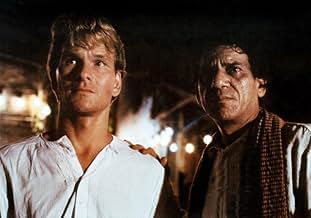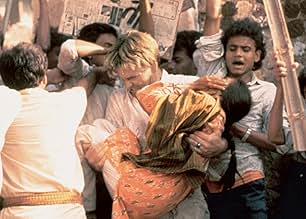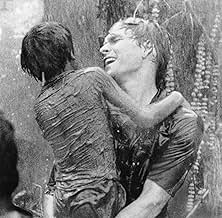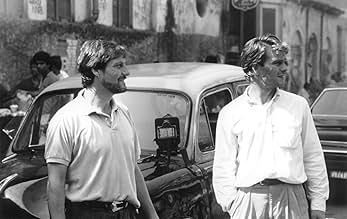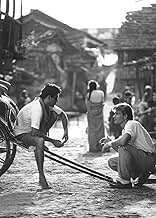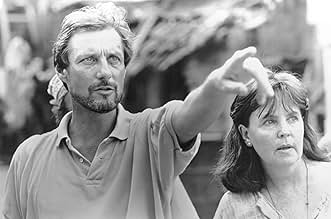IMDb रेटिंग
6.5/10
5.9 हज़ार
आपकी रेटिंग
एक अमेरिकी डॉक्टर, एक ब्रिटिश नर्स और एक अनपढ़ भारतीय किसान इस प्रेरणादायक मूवी में एक कलकत्ता की यहूदी बस्ती को बदलने के लिए एक साथ जुड़ते हैं, पैट्रिक स्वेज़ और पॉलीन कोलिन्स द्वारा अभिनीत... सभी पढ़ेंएक अमेरिकी डॉक्टर, एक ब्रिटिश नर्स और एक अनपढ़ भारतीय किसान इस प्रेरणादायक मूवी में एक कलकत्ता की यहूदी बस्ती को बदलने के लिए एक साथ जुड़ते हैं, पैट्रिक स्वेज़ और पॉलीन कोलिन्स द्वारा अभिनीत .एक अमेरिकी डॉक्टर, एक ब्रिटिश नर्स और एक अनपढ़ भारतीय किसान इस प्रेरणादायक मूवी में एक कलकत्ता की यहूदी बस्ती को बदलने के लिए एक साथ जुड़ते हैं, पैट्रिक स्वेज़ और पॉलीन कोलिन्स द्वारा अभिनीत .
- पुरस्कार
- कुल 1 नामांकन
फ़ीचर्ड समीक्षाएं
A child dies on an operating table in a Texas hospital. The surgeon, Max Lowe (Patrick Swayze), abandons his practice after the fatality and travels to Calcutta, leaving painful memories behind him. At the same time, in the Indian province of Bihar, Hasari and his family are quitting the land. Two years of drought have reduced them to despair, and now they are drifting to the city, hoping to make a new life there.
The story of the film is that of an impoverished community in Calcutta's backstreets, and how with Max Lowe's help the poor people learn to throw off the yoke of oppression. Max gives of his time and talent, and in return these simple folk teach him new perspectives, and enable him to come to terms with his own regrets.
This film is an example of American insensitivity at its worst. It is extremely patronising in its treatment of Indian society and crude in its handling social and moral issues. The film fails utterly to appreciate that a social system that has existed for thousands of years might not need 'straightening out' by a young man from a 200-year-old culture. All the standard American cliches are trotted out. People are urged to 'stand up and be counted', and to 'make choices in their lives'. Individualism and self-reliance are trumpeted brainlessly, as if they were eternal truths. This is the arrogance of youth. American exporters of films would do well to remember that there are ways of living that happen to be distinct from their own - and far wiser.
The plot is brain-numbingly simplistic. An evil Indian 'godfather' and his (even more evil) son are terrorising the City of Joy. Max preaches rebellion to the local people, exhorting them to reject the feudal system by which they have lived since time immemorial. He has been in India for three weeks, but he know best. The film blithely ignores three essential realities, because they happen to be inconvenient. Firstly, street dwellers such as these have to work too long and too hard, and are too worn down by malnutrition, to stage rebellions and construct new clinics on a foreigner's whim. Secondly, even if an age-old feudal system could be discarded overnight (and it can't), something has to fill the vacuum. The film doesn't come close to hinting what sort of social structure will supplant the godfather's regime. Thirdly, the film arrogantly assumes that the people would turn against their own, with whom they have ancient bonds of blood and custom, in order to side with an American stranger who knows nothing of their way of life, and who is free to pack up and leave whenever he wishes.
Indian people have to behave like Americans, lest they lose the sympathy of the American cinema audience. Poor families have to be too proud to beg for food, but this is nonsense in an Indian context. In reality, Hasari and his wife and children would beg without hesitation - and why shouldn't they? If a prostitute were to lure a foreigner into a robbery, would a local poor man tend the foreigner's wounds? And would the prostitute help him? The preparation of the new clinic is all meaningful bustle and smiling self-help, but these are the values of the American frontier, not the backstreets of Calcutta. Hasari's daughter chooses her husband western-style, via a romance, rather than the arranged marriage which would almost certainly happen in real life.
Everything comes about too easily. Hasari needs to double his income, so he does. Max earns the undying love of Calcutta's poor in a few weeks of grudging voluntary work. In the same timespan, the film gives us the full cycle of birth, death and marriage. People are slashed with razors and make complete (scar-free) recovery, without proper medical attention or modern pharmaceuticals. Max decides on the marriage, not the girl's family, and it's Max who takes the place of honour at the wedding ceremony. That's about as likely as water-skiing on the Ganges.
Ennio Morricone's score is extremely low-key, consisting of little more than a few sitar flourishes. It is almost as if the maestro is embarrassed to be associated with this shallow, tactless film. Max says he travelled to Calcutta to find enlightenment. He would stand a better chance if he didn't carry Texas along in his backpack.
The story of the film is that of an impoverished community in Calcutta's backstreets, and how with Max Lowe's help the poor people learn to throw off the yoke of oppression. Max gives of his time and talent, and in return these simple folk teach him new perspectives, and enable him to come to terms with his own regrets.
This film is an example of American insensitivity at its worst. It is extremely patronising in its treatment of Indian society and crude in its handling social and moral issues. The film fails utterly to appreciate that a social system that has existed for thousands of years might not need 'straightening out' by a young man from a 200-year-old culture. All the standard American cliches are trotted out. People are urged to 'stand up and be counted', and to 'make choices in their lives'. Individualism and self-reliance are trumpeted brainlessly, as if they were eternal truths. This is the arrogance of youth. American exporters of films would do well to remember that there are ways of living that happen to be distinct from their own - and far wiser.
The plot is brain-numbingly simplistic. An evil Indian 'godfather' and his (even more evil) son are terrorising the City of Joy. Max preaches rebellion to the local people, exhorting them to reject the feudal system by which they have lived since time immemorial. He has been in India for three weeks, but he know best. The film blithely ignores three essential realities, because they happen to be inconvenient. Firstly, street dwellers such as these have to work too long and too hard, and are too worn down by malnutrition, to stage rebellions and construct new clinics on a foreigner's whim. Secondly, even if an age-old feudal system could be discarded overnight (and it can't), something has to fill the vacuum. The film doesn't come close to hinting what sort of social structure will supplant the godfather's regime. Thirdly, the film arrogantly assumes that the people would turn against their own, with whom they have ancient bonds of blood and custom, in order to side with an American stranger who knows nothing of their way of life, and who is free to pack up and leave whenever he wishes.
Indian people have to behave like Americans, lest they lose the sympathy of the American cinema audience. Poor families have to be too proud to beg for food, but this is nonsense in an Indian context. In reality, Hasari and his wife and children would beg without hesitation - and why shouldn't they? If a prostitute were to lure a foreigner into a robbery, would a local poor man tend the foreigner's wounds? And would the prostitute help him? The preparation of the new clinic is all meaningful bustle and smiling self-help, but these are the values of the American frontier, not the backstreets of Calcutta. Hasari's daughter chooses her husband western-style, via a romance, rather than the arranged marriage which would almost certainly happen in real life.
Everything comes about too easily. Hasari needs to double his income, so he does. Max earns the undying love of Calcutta's poor in a few weeks of grudging voluntary work. In the same timespan, the film gives us the full cycle of birth, death and marriage. People are slashed with razors and make complete (scar-free) recovery, without proper medical attention or modern pharmaceuticals. Max decides on the marriage, not the girl's family, and it's Max who takes the place of honour at the wedding ceremony. That's about as likely as water-skiing on the Ganges.
Ennio Morricone's score is extremely low-key, consisting of little more than a few sitar flourishes. It is almost as if the maestro is embarrassed to be associated with this shallow, tactless film. Max says he travelled to Calcutta to find enlightenment. He would stand a better chance if he didn't carry Texas along in his backpack.
Although the movie might not have the best direction or not one of the best laid picture it still has a lot of good things. If you have visited India (where it has been primarily filmed) and especially Kolkotta city you would see the realistic nature of movie. It depicts the day to day life of a person below the poverty line. It also highlights the morality of foreigners and NGO's who are trying to help the needy. Very often they have to face resistance from local authorities who either want to exploit the masses or think the foreigners are trying to religiously exploit them. In nut shell I liked the movie.
City of Joy is the story of an American Doctor (Patrick Swayze) who runs away from his life and unwittingly lands himself in an entirely different place. Through various actions he ends up helping a woman (Pauline Collins) who tries to help the very poor of Calcutta on a day-to-day basis. City of Joy also contains a story of a farmer (Om Puri) who has lost his farm to the "money lenders" and brings his family to Calcutta to find work so that he can support his family. How all these lives interact is interesting. The poverty and oppression is devastating to see - but worth watching. The story touches your heart and holds your interest throughout the movie.
Patrick Swayze is wonderful in this movie! He is expansive and portrays all of his emotions - anger, frustration, love of friends and joy poignantly! Dirty Dancing, Ghost and City of Joy should have mad Patrick Swayze a serious leading man in the category of Harrison Ford. In later movies you can see his emotions but it is as if the are locked inside his handsome clenched jaws. Nevertheless, Patrick Swayze is a handsome accomplished actor and this film is well worth the watch!
Patrick Swayze is wonderful in this movie! He is expansive and portrays all of his emotions - anger, frustration, love of friends and joy poignantly! Dirty Dancing, Ghost and City of Joy should have mad Patrick Swayze a serious leading man in the category of Harrison Ford. In later movies you can see his emotions but it is as if the are locked inside his handsome clenched jaws. Nevertheless, Patrick Swayze is a handsome accomplished actor and this film is well worth the watch!
The movie is not bad. It is based on the book by the same name by Dominique Lapierre, and if my understanding is right has the author's blessings. The characters even have similar if not same names but it is not the same story. However it is true to the spirit in which the book was written.
Another interesting comparison with the book is that just like the movie, the book is as controversial, especially in India and among middle class Indians and Indians abroad. Indians do not like to speak about their slums to foreigners and do not like foreigners to speak about them by themselves. Rich and middle-class Indians who make about one-fourth of the country are the most influential people in the country and make the interlocutors with the Western world. I know because I am one of them. If our country is our home, this is a skeleton in our closet. And because there is a skeleton in our closet, we try not to step into it and do not let other and hate those who do step in when we are not looking. The controversy is an indication that lot stuff in the movie is actually worth seeing.
Also it is not unusual for a poor man in India to choose to die with dignity than live in shame, Indian girls do flirt even if it is 'untraditional' and there are people who try to live by exploiting the poor, people who most others will call cruel.
The movie could have done a better job capturing the fact that western ideas can affect the way some people in India behave just as Indian ideas make some westerners reformulate their ideas and concepts about life. We can see it here, but this is better captured in the book
So those who do not like the movie try to read the book and those who liked the movie will definitely enjoy the book. As for me, stories of the resilience of Indian slum dwellers only make me more proud to be an Indian.
Another interesting comparison with the book is that just like the movie, the book is as controversial, especially in India and among middle class Indians and Indians abroad. Indians do not like to speak about their slums to foreigners and do not like foreigners to speak about them by themselves. Rich and middle-class Indians who make about one-fourth of the country are the most influential people in the country and make the interlocutors with the Western world. I know because I am one of them. If our country is our home, this is a skeleton in our closet. And because there is a skeleton in our closet, we try not to step into it and do not let other and hate those who do step in when we are not looking. The controversy is an indication that lot stuff in the movie is actually worth seeing.
Also it is not unusual for a poor man in India to choose to die with dignity than live in shame, Indian girls do flirt even if it is 'untraditional' and there are people who try to live by exploiting the poor, people who most others will call cruel.
The movie could have done a better job capturing the fact that western ideas can affect the way some people in India behave just as Indian ideas make some westerners reformulate their ideas and concepts about life. We can see it here, but this is better captured in the book
So those who do not like the movie try to read the book and those who liked the movie will definitely enjoy the book. As for me, stories of the resilience of Indian slum dwellers only make me more proud to be an Indian.
10Pelrad
Bizarre reviews of this film that fail to explain why they are against its excellence don't stand up in the face of critics like Jim Whalley of Cinema Showcase who called it "the best picture of the year" and Susan Granger of WICC who commented that Patrick Swayze gave "the performance of a lifetime". This is the true story of a disillusioned American doctor who, like so many people, (the Beatles and Alanis Morisette, for example) travelled to India to find himself in a search for enlightenment. At first, he is unwilling to help the locals stand up against the oppressive 'godfather' of the area because he feels that all he'd be doing is trying to "drill a hole in water".
Having been to an English-speaking Third World country like India, myself, I found the reactions of the Swayze character extremely true to life. This seems to be the point that many viewers of the film don't seem to understand. I witnessed many Anglo-Americans in a Third World country surprising themselves by blowing up in anger at seeing the locals cowering away from injustice and later being transformed by the love and patience of the poor. I watched this movie while I was in Guyana and it was like an echo of many of the things I was going through and many of the events with which I had faced. Even the characters and their characteristics and reactions in the film matched many of the people I knew in that land!
"City of Joy" was an excellent and faithful adaption of Dominique Lapierre's richly written masterpiece. Om Puri's performance was deserving of an Academy Award. Patrick Swayze's character - his reactions to his surroundings - was extremely realistic. The conclusion of the film was beautifully touching. The strengths of American culture and Indian culture joined together - both races learned to accept one another's ways of life and borrowed virtues from one another's culture to breathe new life into the slums of Calcutta. "City of Joy" is one of the best movies ever made (10 out of 10).
Having been to an English-speaking Third World country like India, myself, I found the reactions of the Swayze character extremely true to life. This seems to be the point that many viewers of the film don't seem to understand. I witnessed many Anglo-Americans in a Third World country surprising themselves by blowing up in anger at seeing the locals cowering away from injustice and later being transformed by the love and patience of the poor. I watched this movie while I was in Guyana and it was like an echo of many of the things I was going through and many of the events with which I had faced. Even the characters and their characteristics and reactions in the film matched many of the people I knew in that land!
"City of Joy" was an excellent and faithful adaption of Dominique Lapierre's richly written masterpiece. Om Puri's performance was deserving of an Academy Award. Patrick Swayze's character - his reactions to his surroundings - was extremely realistic. The conclusion of the film was beautifully touching. The strengths of American culture and Indian culture joined together - both races learned to accept one another's ways of life and borrowed virtues from one another's culture to breathe new life into the slums of Calcutta. "City of Joy" is one of the best movies ever made (10 out of 10).
क्या आपको पता है
- ट्रिवियाAmongst the problems that beset the production were fire-bombings, mass demonstrations, media criticism, accusations of murder, a skyrocketing budget that eventually settled at the $27,000,000 mark, and Warner Bros.' 11th hour pullout that nearly bankrupted the producers.
- गूफ़The school girl in the rickshaw gets dropped daily to St. Xavier's School on Park Street - which is an all boys school.
- भाव
Hasari Pal: All that is not given is lost.
टॉप पसंद
रेटिंग देने के लिए साइन-इन करें और वैयक्तिकृत सुझावों के लिए वॉचलिस्ट करें
- How long is City of Joy?Alexa द्वारा संचालित
विवरण
बॉक्स ऑफ़िस
- बजट
- $2,70,00,000(अनुमानित)
- US और कनाडा में सकल
- $1,46,83,921
- US और कनाडा में पहले सप्ताह में कुल कमाई
- $34,05,890
- 19 अप्रैल 1992
- दुनिया भर में सकल
- $1,46,83,921
- चलने की अवधि2 घंटे 12 मिनट
- रंग
- पक्ष अनुपात
- 1.85 : 1
इस पेज में योगदान दें
किसी बदलाव का सुझाव दें या अनुपलब्ध कॉन्टेंट जोड़ें



